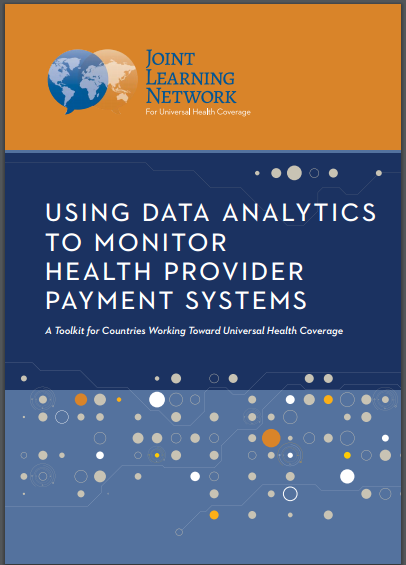JLN Toolkit Empowers Countries to Track Provider Payment Systems
Categories: Announcements, Tools
Excerpted from “A New Monitoring Toolkit Empowers Countries to Track Provider Payment Systems” on the JLN website.
A new data analytics toolkit, released by the Joint Learning Network for Universal Health Coverage (JLN), is aiming to arm the countries with meaningful monitoring of health provider payment systems, even when the data availability is not perfect.
An effective provider payment system is a critical stepping stone to achieving universal health coverage (UHC). Provider payment systems consist of one or more provider payment methods and all supporting systems, such as contracting and reporting mechanisms, information systems, and financial management systems. Nearly every country that is working toward UHC is developing or improving strategic provider payment systems.
It is important to collect information about the implementation and maintenance of provider payment systems, to track how providers are responding, whether objectives for service delivery and other goals are being achieved, and to watch for any unintended consequences, such as overuse of expensive services, excessive referrals, or skimping on necessary care.
“Using Data analytics to Monitor Health Provider Payment Systems: A Toolkit for Countries Working Toward Universal Health Coverage” was launched at the 2nd Annual Universal Health Coverage Financing Forum, held April 20-21, 2017, in Washington DC.
To develop the toolkit, the JLN convened representatives from 13 countries in 2015 and 2016 to share experiences, expertise, and challenges related to monitoring health provider payment systems. With support from technical facilitators, the participating countries – Ghana, India, Indonesia, Kazakhstan, Kenya, Malaysia, Mali, Moldova, Mongolia, Nigeria, the Philippines, and Vietnam – collaboratively applied practical knowledge to develop the toolkit – a step-by-step guide on using data analytics to monitor health provider payment systems, identify trends, track whether payment systems are supporting health system objectives, and get timely information on any unintended consequences.
Claims data and other routine administrative data that are generated by the implementation of provider payment systems should be the main sources of this strategic information. However, many countries do not use these routine data to their fullest potential, particularly to determine whether provider payment systems are achieving their objectives or leading to unintended consequences. These data are often underutilized because of a lack of capacity within the purchasing agency, weak or underdeveloped data systems, or fragmentation in information sources. This toolkit seeks to address the gap in data utilization by providing guidance and tools based on practical experience to help countries implement provider payment monitoring systems that use claims and/or other routine administrative data.
The toolkit provides concrete tools for countries to work through each step by providing a summary of the common challenges faced by participating countries, along with the solutions that they found; a tool (or tools) that can facilitate the step, developed or validated by country participants based on practical experience; examples of country experiences; and links to additional resources.
A carefully developed provider payment system can be a powerful instrument for making progress toward UHC. Countries can draw on the collective experience presented in this toolkit to create an effective provider payment monitoring system that generates information on an ongoing basis to keep a tab on whether objectives are being met and any emerging unintended consequences.




